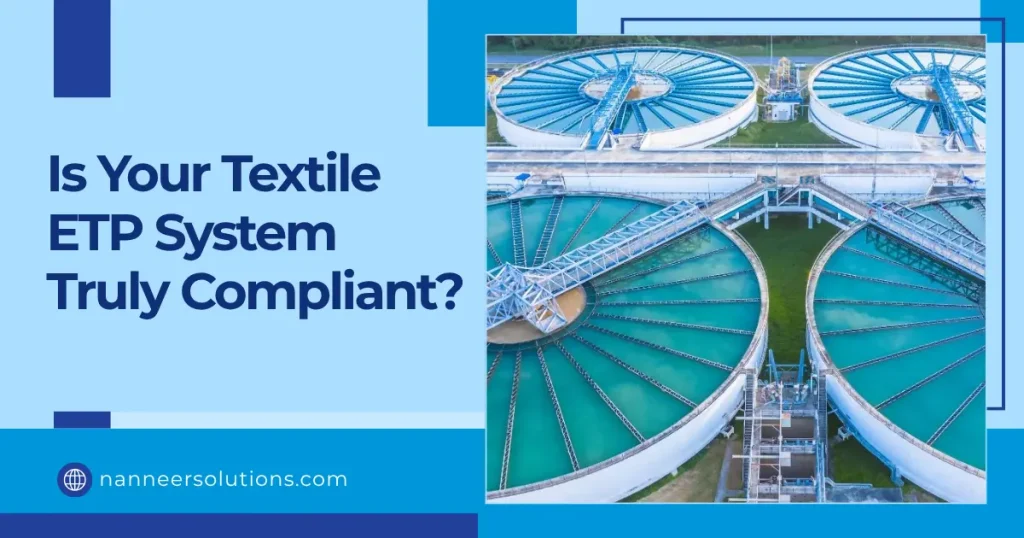Importance of ETP in Textile Industry
The textile industry produces some of the most challenging industrial wastewater on the planet. Unlike other manufacturing sectors, textile effluents contain a complex mixture of dyes, chemicals, heavy metals, and organic compounds that conventional treatment systems cannot handle effectively.
The Unique Complexity of Textile Wastewater
Textile manufacturing processes generate wastewater that’s dramatically different from standard industrial effluents. Each production stage—from fibre preparation and dyeing to printing and finishing—introduces specific contaminants that require targeted treatment approaches.
What makes textile effluent so challenging?
- Intense colour loads from synthetic and natural dyes
- High chemical oxygen demand (COD) levels exceeding 2,000 mg/L
- Extreme pH fluctuations ranging from 2 to 12
- Heavy metal contamination from mordants and fixing agents
- High temperature variations affect treatment efficiency
- Non-biodegradable compounds resisting conventional biological treatment
A single textile facility can discharge 200-350 litres of wastewater per kilogram of fabric produced. This massive volume, combined with toxic contaminants, makes generic treatment systems inadequate and potentially disastrous.
Why Standard Treatment Plants Fail for Textiles
Generic wastewater treatment plants designed for domestic or light industrial use catastrophically fail when handling textile effluents. The reasons are both chemical and operational.
Colour removal challenges represent the most visible failure. Synthetic dyes, particularly azo dyes used extensively in textile processing, remain stable even after conventional biological treatment. The result? Colored discharge that violates environmental norms and attracts immediate regulatory action.
Chemical resistance is another critical issue. Many textile chemicals are specifically designed to be permanent and wash-resistant—the same properties that make them excellent for fabrics make them nearly impossible to break down using standard treatment methods.
The fluctuating nature of textile effluents overwhelms standard systems. Morning batches may be highly acidic due to bleaching operations, while afternoon discharges could be alkaline from mercerization processes. Standard treatment plants lack the flexibility and buffer capacity to handle such variations.
The Specialized Treatment Approach Textiles Demand
Multi-Stage Treatment Architecture
Textile effluent treatment requires a carefully orchestrated series of treatment stages, each addressing specific contaminant groups:
Physical-Chemical Treatment: Coagulation and flocculation remove suspended solids, heavy metals, and partially decolorize the effluent. This stage is critical for textile wastewater because it handles contaminants that biological systems cannot process.
Advanced Oxidation Processes: Technologies like ozonation, Fenton’s reaction, or electrochemical oxidation break down recalcitrant dye molecules that resist conventional treatment. This stage is what truly differentiates textile treatment from standard systems.
Biological Treatment: Specialized acclimatized bacterial cultures handle biodegradable organic matter. However, unlike standard plants, textile treatment uses extended aeration and specific retention times to handle high organic loads.
Tertiary Polishing: Final treatment through membrane filtration or activated carbon ensures consistent discharge quality meeting stringent colour and COD standards.
The Regulatory Imperative
Environmental regulations for textile industries have become progressively stringent. Current norms mandate:
- Colour levels below 100 Hazen units
- COD under 250 mg/L for discharge
- Complete removal of heavy metals
- Zero liquid discharge (ZLD) in many regions
Non-compliance carries severe penalties—fines reaching crores, production shutdowns, and potential criminal liability for management. Specialized treatment isn’t optional; it’s legally mandatory for continued operations.
Economic Benefits Beyond Compliance
Investing in specialized textile effluent treatment delivers substantial economic returns:
Water recycling potential allows facilities to reuse 40-60% of treated water in non-critical processes, dramatically reducing freshwater costs. In water-scarce regions, this advantage alone justifies the investment.
Chemical recovery systems integrated into advanced treatment plants can reclaim valuable chemicals, such as caustic soda, thereby reducing raw material costs by 15-25%.
Enhancing brand reputation through environmental compliance opens doors to international markets, where sustainability certifications are mandatory for suppliers.
Technology Integration: The Winning Formula
Successful textile effluent treatment combines multiple proven technologies:
- Equalization tanks buffer flow and composition variations
- Advanced oxidation for colour and toxicity removal
- Membrane bioreactors provide superior biological treatment
- Reverse osmosis enabling water recycling and ZLD compliance
- Automated monitoring ensures consistent performance
Making the Investment Decision
Textile manufacturers face a clear choice: invest in specialized treatment infrastructure or face escalating compliance costs, operational disruptions, and market exclusion.
The specialized nature of textile wastewater requires expert partners who understand both the chemistry and economics. Nanneer Solutions brings extensive experience in designing and implementing comprehensive textile effluent treatment systems that transform compliance challenges into operational advantages, ensuring your facility meets environmental standards while optimizing water management costs.
Get a FREE comprehensive effluent analysis and discover if your current system meets the latest environmental standards. Our textile wastewater specialists will evaluate your facility’s specific challenges and provide a detailed compliance roadmap—at no cost.





